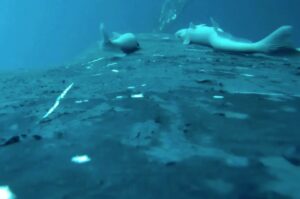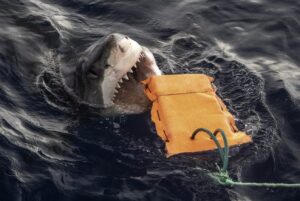The Caribbean’s position at the crossroads of continents and oceans gives it some of the world’s best diving. Each island offers different marvels for both expert and novice divers. Some places feature volcanoes; others, limestone atolls that encourage the growth of complex reef and cave systems. Here, we offer an island-by-island hit list of the Caribbean’s best diving, from Belize’s famous Great Blue Hole to the lava walls of unspoiled, little-known Saba.
Tobago
The nutrient-rich Orinoco River in Venezuela blesses Trinidad’s sister isle. Along with warm temperatures of 27°C to 30°C, life thrives underwater. The shallow seas host over 300 species of coral and 700 species of fish. Tobago has about 20 sunken shipwrecks which have become their own artificial reefs over the years.
Strong currents allow for drift diving, where you can glide along various sites with relative ease. Tobago’s waters are slightly choppy year-round, especially from November to January.

Exploring a shipwreck in Tobago: Photo: Courtesy Tobago Beyond
Divers see the world’s largest living brain coral at the Kelleston Drain site near Little Tobago. The coral is three metres high by 5.3 metres wide. Large, brightly colored sea fans and rods add to the biodiversity. This coral garden is an easier dive than most. Those wanting to up their level can go to Goat Island’s kaleidoscopic Japanese Gardens and the animal-rich Diver’s Dream at Crown Point.
The island’s three most popular shipwrecks are MV Maverick, MV Roundtable, and Trinity.
Grenada
While Grenada has excellent natural coral at Japanese Gardens, Dragon Bay, and Kohanee, it is the artificial reef capital of the Caribbean. In 2006, Grenada opened the world’s first underwater sculpture park on the west coast.
Each concrete figure weighs 15 tons and is bolted to the seafloor. The park’s more than 75 sculptures are scattered eerily about the bottom. The most famous ones are the Vicissitudes, a circle of children holding hands, the Lost Correspondent, a man at a desk with a typewriter, a cyclist molded into a rock wall, and Christ of the Deep with his arms outstretched. Sea sponges, barnacles, fish, and corals make their home on these sculptures.

Underwater Sculpture Park. Photo: R Gombarik/Shutterstock
Grenada also features the Titanic of the Caribbean. This 182m long cruise ship, once called the Bianca C, caught fire and sank in 1961, with one fatality. It is now one of the top ten diving spots in the world. Other sunken vessels include the MV Shakem, MV Veronika, Buccaneer, HV Hema, and HV Hildur.
Dominica
Dominica’s volcanic mystique does not stop at its inland craters and black sand. Its diving sites consist of underwater cliffs and craters, deep crevices, and boulder fields. Wall diving is particularly popular here, particularly at Scott’s Head Marine Reserve, Cabrits National Park, and Salisbury Marine Reserve. Apart from diving, the volcanic sideshow includes pinnacles, ridges, thermal springs, and fumaroles. Diving in Dominica is nothing like the mellow stylings you would find in Tobago or Grenada.

Scott’s Head at Dominica’s southwestern tip overlooks protected Soufrière Bay. Photo: Courtesy Dominica Tourism Authority
The most popular wall dive is the almost vertical, 30m Scott’s Head. Another is L’Abym, which translates as ‘the abyss’. The most spectacular of all, however, is further out to sea. You have the opportunity (by permit) to see the island’s 200 sperm whales.
St Vincent and the Grenadines
The best diving occurs in three locations in St Vincent: the islands of Bequia, Mustique, and the Tobago Cays. An isolated island in the Grenadines, Bequia is famous for its turtle conservation programs and its drift and wall dives. It offers a rounded experience for all divers.

Tobago Cays. Photo: Larwin/Shutterstock
Mustique, another isolated island, features over 20 dive sites.
Tobago Cays Marine Park has the most scuba activity in the Grenadines, with multiple shallow reefs, including Mayreau Gardens and Egg Reef.
St Lucia
The base of the Petit Piton volcanic plug is the perfect way to kick off a Lucian diving adventure. Much like Dominica’s steep underwater cliffs, Petit Piton affords a great first experience with wall diving. Reef creatures such duster worms and gorgonians haunt the Piton’s wall.

Gros and Petit Pitons. Photo: photoshopav/Shutterstock
There are two exciting shipwreck dives: Lesleen M Wreck, a 51m vessel from the 1980s, and Daini Koyomaru Wreck, a Japanese vessel from the 1990s sunk to create a reef.
Saba
This Dutch island is a lesser-known treasure and is nicknamed the Unspoiled Queen for a reason. Although only 12 square kilometres, Saba is a dormant volcano with rugged mountainous and cliffs that extend into its depths. Vibrantly colored marine species cover the underwater lava walls.
Because it is virtually unspoiled and tourism is not as popular here, the water remains clear, and visibility is almost perfect. Divers can check out the 100m high Pinnacles, the Elkhom coral gardens, Man o’ War, and Diamond Rock.
Its diving is premier yet underrated. You can dive only with guides, through official centres. These regulations are in place to prevent pollution or damage to the reefs.
Bonaire
The ‘B’ of the ABC islands of the Dutch Caribbean is famous for its world-class diving. Its 85 diving sites house over 300 species of fish and 50 species of coral. Fifty-four of these sites are on Klein Bonaire, an uninhabited island 800m away from mainland Bonaire.
The best spots include Bari Reef (with over 350 fish species), 1,000 Steps (actually 70-something steps), Something Special, and a cargo shipwreck from the 1980s called Hilma Hooker.
The Bahamas
Not diving in the Bahamas is considered a sin. Forget the typical postcard-blue waters for a second and look at its numerous blue holes. The Bahamas’ abundant blue holes and cave systems make for more adventurous diving, especially freediving and cave diving.
Dean’s Blue Hole is the world’s second deepest, plunging down 202m. It is a freediver’s dream, with an annual competition called Vertical Blue. The farthest anyone had ever gone was 126m in 2021 by Alexey Molchanov.

The famous Dean’s Blue Hole on Long Island, Bahamas. Photo: Sven Hansche/Shutterstock
Another is Andros Island’s The Crater, in which erosion of the ocean floor has created a cave system.
A less popular treasure is Owl’s Hole in Grand Bahama. It is a small, nine-metre swimming pool-looking hole, which is actually a cave entrance. Venturing into its depths requires more experience, in order to navigate the tight corners and crevices.
Lucayan National Park has one of the world’s longest cave systems. Its 18m depth splits evenly into 9m of freshwater on top of 9m of saltwater.
Cayman Islands
Grand Cayman, Little Cayman, and Cayman Brac are the little archipelago’s best and most active diving spots. In Grand Cayman, scuba divers take to Stingray City. Here, stingrays frequent shallow sand bars and interact with people. It is ideal for diving beginners and their families.

A diver explores the cracks, crevices, and holes in a coral reef on Grand Cayman Island. Many reef species, such as silversides, prefer the shadowy protection of these dark areas. Photo: Ethan Daniels/Shutterstock
Little Cayman has the infamous Bloody Bay Wall, an underwater mountain range that plunges over 600m down. Corals, sea plants, rods, and a rare species of yellow sea sponge plaster the wall. Its several sections include Three Fathoms Wall, Donna’s Delight, Randy Gazebo, and Marilyn’s Cut.
At Cayman Brac, you can explore a Russian destroyer, formerly called Destroyer 356. The former Cuban vessel, given to Castro by the Russians in the 1980s, was sold to the Caymans and was sunk in 1996. Its name is now MV Captain Keith Tibbetts.
Belize
Now on to the godfather of blue holes. Belize’s great blue hole is a must. Its popularity as a world-class diving site became even more pronounced when pioneer Jacques Cousteau declared it one of the world’s top five diving sites. The sinkhole sits on the Lighthouse Reef Atoll and resulted from the last Ice Age thousands of years ago. It has excellent visibility and clear water. The hole’s walls are covered in stalactites, sea rods, coral, and resident sea creatures.
However, the farther down you go, the more dangerous it becomes. At 91m, scientists detected anoxic water — laced with hydrogen sulfide. Additionally, authorities found two bodies, believed to have been freedivers.

Great Blue Hole in Belize. Photo: Jamiesonamission/Shutterstock






